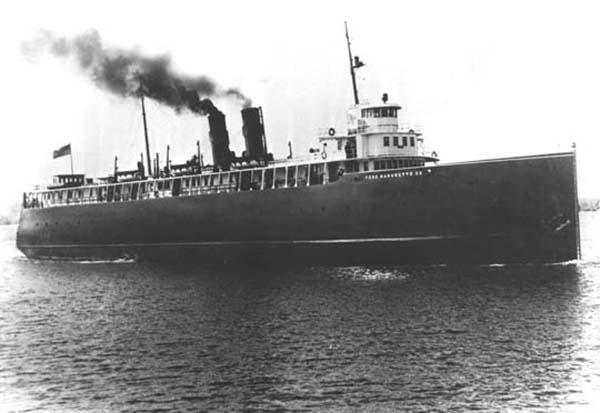Fed up with the long transit time though Chicago, the Flint and Pere Marquette railroad decided to ferry their shipments across Lake Michigan.
The railroad bottleneck of Chicago has always been a problem for shippers. The beltline railroads around Chicago did not exist in the late 1800s and railroads were looking for a way around Chicago. Sometimes freight cars could take a week to transit Chicago and that was not a good selling point for the railroads. The solution was to ship railroad cars across Lake Michigan, thereby eliminating the bottleneck.
In 1874 the Flint & Pere Marquette railroad reached Ludington. The following year the Flint and Pere Marquette initiated a break-bulk service across Lake Michigan to Sheboygan, Wisconsin using the John Sherman, a small side-wheeler. The John Sherman was too small for the amount of cargo the railroad wanted to ship and in 1876 the railroad chartered a variety of steamers from the Goodrich transpiration Company.
Flint & Pere Marquette Railroad orders ships
The railroad found the relationship with the Goodrich Transportation company to be lacking and in 1883 they ordered their own steamships. Aptly named the Flint & Pere Marquette 1 and 2, the steamers were also rigged as schooners and had reinforced hulls for winter operations. With an increase of traffic the railroad ordered three more ferries and, showing the same lack of imagination, continued the names with a number sequence.
Lake Michigan’s First Steel Car Ferry
December 30, 1896 saw the launch of the first steel car ferry on Lake Michigan. Built by the F.W. Wheeler & Company, the Pere Marquette was launched and put into service between Ludington and Manitowoc, Wisconsin. The Pere Marquette had the ability to carry rail cars, eliminating the need for break-bulk service. Rail traffic increased and in 1900 the Pere Marquette railroad ferries carried 27,000 railcars across the lake. By 1904 this number had increased to 75,000 railcars and more ferries were launched.
Disaster on the Lake—the sinking of Pere Marquette 18
The only loss of a Pere Marquette Railroad ferry occurred in 1910. The Pere Marquette 18 was headed to Milwaukee with a load of 29 railcars. There were very heavy seas and the ferry radioed for assistance saying that she was taking on water. The Pere Marquette 17 was a few miles away and promptly responded. However as the Pere Marquette 17 pulled alongside the 19 took on a great deal of water and quickly sank. Twenty-five survivors were rescued, but twenty-eight people died, including two crew members of the Pere Marquette 17, who were crushed when their lifeboat crashed alongside the 17.
New Names for the Ferries
Between 1930 and 1940 the Pere Marquette changed their naming strategy for the ferries. The decade following 1930 saw the launch of the City of Saginaw, City of Flint, and the City of Midland. The City of Midland had the distinction of being the world’s largest car ferry. The City of Flint gained acclaim for sailing 101,000 miles in 1931.
Chesapeake and Ohio takes the reins the Pere Marquette
On June 6, 1947 the Pere Marquette became a fallen flag and merged into the Chesapeake and Ohio (C&O) railroad. The familiar symbol of a sleeping cat, Chessie, appeared on the smokestacks of the ferries and the C&O ordered more ferries. The Spartan and Badger entered the fleet in 1952 and 1953 respectively. By 1960 the fleet was averaging eighteen sailings a day and carrying 132,000 railcars, 54,000 automobiles, and 153,000 passengers.
The Demise of the C&O Car Ferries
The C&O started diverting rail traffic through Chicago in 1972 after signing a deal with the Milwaukee Road. Within two years the C&O petitioned to abandon the car ferry routes. After a long battle the C&O railroad exited the car ferry business in 1983. For a few short years the Michigan-Wisconsin Transportation Company (MWTC) ferried railcars across the lake. However in 1990 the MWTC went bankrupt and the era of rail ferry came to an end in Ludington. Despite the end of the rail ferries, in 1992 the SS Badger was returned to service as an automobile ferry.
The SS Badger
Today, during the summer months the remaining active car ferry from the C&O fleet carries passengers and autos across Lake Michigan. From Ludington to Manitowoc the ferry still takes the same route as its predecessors. Run by the Lake Michigan Carferry Service, the SS Badger takes four hours for the journey. Although the railroad no longer comes close to the piers, the memories of a bygone era are kept alive.
References:
- Hilton, George W. The Great Lakes Car Ferries, Howell-North, Berkeley Ca. 1962, 282pp
- Ludington Daily News, Ludington’s Carferries, the Rise, Decline & Rebirth of a Great Lakes Fleet 1874-1997, Walsworth, Marceline Mo 1997, 127pp








